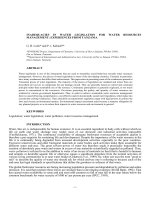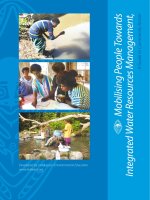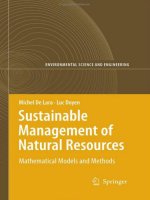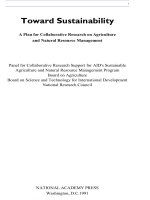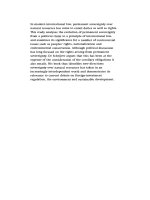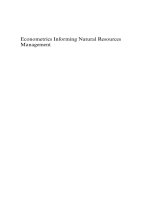Econometrics Informing Natural Resources Management potx
Bạn đang xem bản rút gọn của tài liệu. Xem và tải ngay bản đầy đủ của tài liệu tại đây (1.49 MB, 406 trang )
Econometrics Informing Natural Resources
Management
NEW HORIZONS IN ENVIRONMENTAL ECONOMICS
Series Editors: Wallace E. Oates, Professor of Economics, University of Maryland, USA and Henk Folmer,
Professor of General Economics, Wageningen University and Professor of Environmental Economics,
Tilburg University, The Netherlands
This important series is designed to make a significant contribution to the development of the principles
and practices of environmental economics. It includes both theoretical and empirical work. International
in scope, it addresses issues of current and future concern in both East and West and in developed and devel-
oping countries.
The main purpose of the series is to create a forum for the publication of high quality work and to show
how economic analysis can make a contribution to understanding and resolving the environmental prob-
lems confronting the world in the twenty-first century.
Recent titles in the series include:
The Economic Valuation of the Environment and Public Policy
A Hedonic Approach
Noboru Hidano
Global Climate Change
The Science, Economics and Politics
James M. Griffin
Global Environmental Change in Alpine Regions
Recognition, Impact, Adaptation and Mitigation
Edited by Karl W. Steininger and Hannelore Weck-Hannemann
Environmental Management and the Competitiveness of Nature-Based
Tourism Destinations
Twan Huybers and Jeff Bennett
The International Yearbook of Environmental and Resource Economics 2003/2004
A Survey of Current Issues
Edited by Henk Folmer and Tom Tietenberg
The Economics of Hydroelectric Power
Brian K. Edwards
Does Environmental Policy Work?
The Theory and Practice of Outcomes Assessment
Edited by David E. Ervin, James R. Kahn and Marie Leigh Livingston
The International Yearbook of Environmental and Resource Economics 2004/2005
A Survey of Current Issues
Edited by Tom Tietenberg and Henk Folmer
Voluntary Approaches in Climate Policy
Edited by Andrea Baranzini and Philippe Thalmann
Welfare Measurement in Imperfect Markets
A Growth Theoretical Approach
Thomas Aronsson, Karl-Gustaf Löfgren and Kenneth Backland
Econometrics Informing Natural Resources Management
Selected Empirical Analyses
Phoebe Koundouri
Econometrics
Informing Natural
Resources
Management
Selected Empirical Analyses
Edited by
Phoebe Koundouri
Senior Lecturer, Department of Economics, University of
Reading, UK; Senior Research Fellow, Department of
Economics, University College London, UK; Member of The
World Bank Groundwater Management Advisory Team
(GWMATE)
NEW HORIZONS IN ENVIRONMENTAL ECONOMICS
Edward Elgar
Cheltenham, UK • Northampton, MA, USA
© Phoebe Koundouri, 2004
All rights reserved. No part of this publication may be reproduced, stored in
a retrieval system or transmitted in any form or by any means, electronic,
mechanical or photocopying, recording, or otherwise without the prior
permission of the publisher.
Published by
Edward Elgar Publishing Limited
Glensanda House
Montpellier Parade
Cheltenham
Glos GL50 1UA
UK
Edward Elgar Publishing, Inc.
136 West Street
Suite 202
Northampton
Massachusetts 01060
USA
A catalogue record for this book
is available from the British Library
ISBN 1 84376 922 0 (cased)
Printed and bound in Great Britain by MPG Books Ltd, Bodmin, Cornwall
Dedication
To Nikitas, my inspiration and rock, hopefully throughout this fascinating
journey.
List of contributors ix
Acknowledgements xii
INTRODUCTION
1 Econometrics informing natural resources management:
introducing the book 3
Phoebe Koundouri
2 Sustainability informed by econometrics: the dynamics
of the long-run discount rate 14
Ben Groom and Phoebe Koundouri
PA RT I STATIC AND DYNAMIC ESTIMATION OF NATURAL
RESOURCE DEMAND
3 Water pricing reforms in Mexico: the case of the
manufacturing sector 45
Hilda Guerrero Garcia Rojas and Alban Thomas
4 Residential water demand in the Slovak Republic 83
Laurent Dalmas and Arnaud Reynaud
5 Estimating urban water demands: a dynamic approach 110
María A. García-Valiñas
PA RT II VALUATION METHODS
6 Households’ valuation of domestic water in Indonesia:
revisiting the Supply Driven Approach 127
Arief Anshory Yusuf and Phoebe Koundouri
7 Conflicts in wildlife conservation: aggregating total
economic values 143
Timothy Swanson and Andreas Kontoleon
vii
8 Contingent ranking of river water quality improvements 175
Stavros Georgiou, Ian Bateman, Matthew Cole and
David Hadley
9 Environmental resource information and the validity of
non-use values: the case of remote mountain lakes 195
Ben Groom, Andreas Kontoleon and Timothy Swanson
PA RT III ESTIMATION UNDER UNCERTAINTY
10 The role of risk properties and farm risk aversion on
crop diversity conservation 231
Salvatore Di Falco and Charles Perrings
11 Stochastic production in a regulated fishery: the
importance of risk considerations 247
Phoebe Koundouri and Marita Laukkanen
12 Is irrigation water demand really convex? 263
Christophe Bontemps, Stéphane Couture and Pascal Favard
PA RT IV RECENT ADVANCES IN ECONOMETRICS METHODS
APPLIED TO NATURAL RESOURCE MANAGEMENT
13 Contrasting conventional with multi-level modelling
approaches to meta-analysis: expectation consistency
in UK woodland recreation values 281
Ian J. Bateman and Andrew P. Jones
14 Individual-specific welfare measures for public goods:
a latent class approach to residential customers of
Yo r kshire Water 316
Riccardo Scarpa, Kenneth G. Willis and Melinda Acutt
15 Estimation of resource management objectives through
empirical likelihood: can regulatory policies and
economic optimization be reconciled? 338
Marita Laukkanen
16 Examining the Environmental Kuznets Curve: what can
Kernel estimation say? 354
Salvatore Di Falco
Index 373
viii Contents
Contributors
Melinda Acutt,Revenue and Economic Policy Unit, Yorkshire Water.
Arief Anshory Yusuf, Lecturer, Department of Economics and Develop-
ment Studies, Faculty of Economics, Padjadjaran University, Bandung,
Indonesia.
Ian Bateman,Professor, Centre for Social and Economic Research on the
Global Environment (CSERGE) and Zuckerman Institute for Connective
Environmental Research (ZICER), School of Environmental Sciences,
University of East Anglia, UK. Managing Editor, Journal of Environmental
and Resource Economics.
Christophe Bontemps, Senior Research Fellow, INRA, Department of
Economics, University of Toulouse, France.
Matthew Cole, Senior Lecturer, Department of Economics, University of
Birmingham, UK.
Stéphane Couture, Senior Research Fellow, LEF-ENGREF/INRA,
Department of Economics, University of Toulouse, France.
Laurent Dalmas,Research Fellow, Faculty of Law, Political Science,
Economics and Business, CEMAFI, University of Nice-Sophia Antipolis,
Nice, France.
Salvatore Di Falco,Visiting Scholar, Agricultural and Resource Economics
Department, University of Maryland, College Park, USA and Research
Fellow, Department of Economics, National University of Ireland, Galway,
Ireland.
Pascal Favard,Professor of Economics, University of La Rochelle, France.
ix
María A. García-Valiñas,Research Fellow, Department of Economics,
University of Oviedo, Spain.
Stavros Georgiou, Senior Research Fellow, Centre for Social and
Economic Research on the Global Environment (CSERGE), School of
Environmental Sciences, University of East Anglia, UK.
Ben Groom,Research Fellow, Department of Economics and Centre for
Socio-Economic Research on the Global Environment (CSERGE),
Department of Economics, University College London, UK.
Hilda Guerrero Garcia Rojas,Research Fellow, LEERNA-INRA,
University of the Social Sciences, Toulouse, France.
David Hadley,Research Fellow, Programme on Environmental Decision-
Making, Centre for Social and Economic Research on the Global
Environment (CSERGE), School of Environmental Sciences, University
of East Anglia, UK.
A.P. Jones,Research Fellow, Programme on Environmental Decision-
Making, Centre for Social and Economic Research on the Global
Environment (CSERGE), School of Environmental Sciences, University
of East Anglia, UK.
Andreas Kontoleon, Lecturer, Department of Land Economics, University
of Cambridge, UK.
Phoebe Koundouri, Senior Lecturer in Economics (B), Department of
Economics, University of Reading, UK; Senior Research Fellow, Depart-
ment of Economics University College London, UK and Member of
World Bank Groundwater Management Advisory Team (GW-MATE),
The World Bank, US.
Marita Laukkanen, MTT Agrifood Research Finland, Economic
Research, Helsinki, Finland.
marita.laukkanen@mtt.fi
Charles Perrings,Professor of Environmental Economics and Environ-
mental Management,Departmentof Environment, University of York, UK.
Managing Editor, Environment and Development Economics.
cap
x Contributors
Arnaud Reynaud, Senior Research Fellow, LEERNA-INRA, University of
Toulouse 1, France.
Riccardo Scarpa, Lecturer in Environmental and Applied Economics,
Environment Department, University of York, UK.
rs
Timothy Swanson,Professor of Economics and Law, Department of
Economics, University College London, UK.
Alban Thomas,Professor of Environmental Economics and Econometrics,
LEERNA-INRA, University of the Social Sciences, Toulouse, France.
Kenneth G. Willis,Professor of Environmental Economics, School of
Architecture, Planning and Landscape (SAPL), Centre for Research in
Environmental Appraisal and Management (CREAM), University of
Newcastle, UK.
Contributors xi
Acknowledgements
My overwhelming debt is to all the contributing authors of this book, for
their devotion to the completion of their chapters in a relatively short time
period and their participation in the reviewing process of the included
chapters. I owe a special intellectual debt to all of them, for providing me
with a stimulating and challenging environment, not only throughout the
period of editing this book, but also throughout my years in academia.
I am also grateful to all my colleagues from the Department of Economics
at the University of Reading and the Department of Economics and
CSERGE/Economics at University College London, for insightful com-
ments and suggestions that have improved the original draft of the book a
great deal. Special thanks to Ben Groom for refereeing and proofreading a
number of the included chapters.
I am also indebted to two interdisciplinary research teams that I work
with. My thanks go, firstly, to every one of the 80 researchers working for
the ARID Cluster of European projects that I co-ordinate under the Fifth
Framework Program of the European Commission, as well as DG
Research for funding this clustering initiative. Secondly, I am indebted to
my GW-MATEs from the Groundwater Management Advisory Team of
the World Bank, for widening my understanding of the needs and chal-
lenges faced by the developing world. Both of these teams have provided
me with feedback from other scientific disciplines, as well as field experi-
ences, that enriched my way of thinking about the economics of resource
management and broadened my understanding of the scientific and policy
issues involved.
I also wish to thank my publisher, Edward Elgar Publishing, whose staff
were enthusiastic about this project from the beginning. I owe special
thanks to Dymphna Evans, my commissioning editor.
Finally a special debt is owed to my partner, family and friends, who put
up with me in such a discreet and endearing manner and who sustain a
healthy suspicion about all the writings of economists.
The publishers wish to thank the following who have kindly given permis-
sion for the use of copyright material.
Kluwer Academic Publishers for the article: ‘Applying Geographical
Information Systems (GIS) to Environmental and Resource Economics’ by
xii
I.J. Bateman, A.P. Jones, A.A. Lovett, I. Lake and B.H. Day, Environmental
and Resource Economics, 22 (1), 219–69, 2002.
Every effort has been made to trace all the copyright holders but if any have
been inadvertently overlooked the publishers will be pleased to make the
necessary arrangements at the first opportunity.
Acknowledgements xiii
INTRODUCTION
resources management: introducing
the book
Phoebe Koundouri
The increasing scarcity of natural resources (in terms of quantity and
quality) is one of the most pervasive allocation issues facing development
planners throughout the world. The need for sustainable management of
these valuable resources has become a critical policy concern. Econometrics
is a tool that can inform and facilitate such management. However, it is only
recently that natural resource management has attracted the attention and
interest of a critical mass of applied econometricians.
This volume outlines the fundamental principles and difficulties that
characterize the challenging task of using econometrics to inform natural
resourcemanagementpoliciesandillustratesthemthrough a numberof case
studies from all over the world. The book aims to be a comprehensive sketch
of the broader picture of the state of the art in the area of Econometrics
applied to Environmental and Natural Resource Management. The selec-
tion of contributions and referee process opted for a wide range of econo-
metric techniques that can be used to inform naturalresource management,
while keeping a balance between methods and applications. Applications
concern atmospheric carbon reduction, water resource management,
wildlife, crop and aquatic biodiversity conservation, fisheries management,
as well as broader issues on the relationship between growth, sustainability
and the environment. The case studies have been carefully chosen as being
of major concern in the arena of environmental policy, mainly in Europe
(both EU member states and accessing countries), but also in the US and
some developing countries.
The volume begins with a review of the arguments for and the implica-
tions of employing Declining Discount Rates (DDRs) in cost benefit analy-
sis (CBA) and in the analysis of economic growth and sustainability.Groom
and Koundouri show that there exist several growth models in which a
relationship has been found between the long-run equilibrium under DDRs
and equilibrium when a zero discount rate is employed. This can have the
3
effect of pushing the optimum under DDRs away from the conventional
utilitarian outcome towards the Green Golden Rule (GGR) level of capital
or environmental stocks. Furthermore, in response to worries that the GGR
places weight on the future at too great a cost to the present, Groom and
Koundouri highlight the result of Li and Löfgren (2000): DDRs can evoke a
solution to resource management problems in which the objective function
explicitly takes into account the preferences of present and future gener-
ations. Neither zero nor conventional discounting achieves this solution.
It is in these senses that DDRs can be seen to encourage a more equal treat-
ment of generations and to promote sustainable outcomes.
Groom and Koundouri also provide a methodology for the estimation of
a working schedule of DDRs assuming that future discount rates and the
past provide information about the future. The implications of this are that
a correctly specified model of discount rates provides a schedule of DDRs
which values atmospheric carbon reduction 150% higher than conventional
exponential discounting, and almost 90% higher than incorrectly specified
models. In this sense sustainable outcomes are more likely to emerge from
project appraisal with DDRs, but given that the theory of DDRs for CBA
reviewed relates to the socially efficient discount rate, such outcomes can
also be thought of as efficient.
The rest of the book is divided into four parts. Part I, focuses on the static
and dynamic estimations of the demand function for natural resources. The
applications concern water resources management and allocation in the
industrial and residential sectors. In particular, the first application con-
cerns water pricing reforms in the manufacturing sector of a developing
country, Mexico. The second application focuses on residential demand
estimation in an EU (European Union) accessor, the Slovak Republic.
Finally, the third application concerns estimation of the dynamic demand
for urban residential and industrial water in an EU member state.
Given the public good characteristics and externalities inherent in
the nature and allocation of most natural resources and environmental
services, quite often their demand needs to be retrieved in the absence of an
underlying market where these resources are traded. Part II of the book
focuses on methods that can be employed to measure willingness to pay
(WTP) for flows and stocks of environmental goods and services. In
particular, this part of the book introduces policy-oriented applications of
valuation methods, as well as applications of advances in the methodology
of valuation methods. In brief, these are the hedonic pricing technique,
the contingent valuation method, the contingent ranking technique, and
Delphi experiments (consultation/consensus of experts).
Parts I and II of the book have addressed problems in which agents are
assumed to function under certainty. However, stochasticity and resulting
4 Introduction
risk are inherent in most problems of natural resource and environmental
management. Part III of the book focuses on the challenges that face
econometricians when faced with the difficult task of assessing demand and
supply attributes of stocks and flows of natural resources when these are
used as inputs in a stochastic production process. Applications concern the
role of risk and risk preferences in crop diversity conservation and fisheries
management, as well as characterization of irrigation water demand under
uncertainty.
Finally, Part IV of the book introduces recent advances in the use
of econometrics applied to natural resource management. These include
advances relevant to the valuation literature, as well as to the more general
environmental management literature. In particular, this final part of the
book includes a chapter that presents a variety of meta-analysis models,
contrasting conventionally estimated models with those provided by novel,
multi-level modelling techniques, as well as a chapter on the evaluation of
new estimation techniques for valuing taste heterogeneity. A third chapter
introduces a new econometric methodology for examining whether regula-
tions imposed by a management authority comply with the economic
objective of discounted rent maximization. Finally, the last chapter of the
book uses non-parametric econometric techniques to evaluate the rela-
tionship between economic development and environmental quality, the
so-called Environmental Kuznets Curve.
PART I: STATIC AND DYNAMIC ESTIMATION OF
NATURAL RESOURCE DEMAND
The chapter by Guerrero and Thomas deals with the effects of water
pricing on the manufacturing sector in Mexico. In particular, the
authors investigate the responsiveness of water demand in the Mexican
manufacturing section and hence the efficiency of pricing as an economic
tool for water demand management. Estimation is performed on a
translog cost function, using a sample of 500 Mexican firms distributed
in eight industries (mining, food, sugar, beverages, textiles, paper, chem-
icals, and steel) for the year 1994. Empirical results demonstrate that
industrial water demand is not very sensitive to water price, and that water
is a substitute for both labour and materials in the sense of the
‘Morishima Elasticity of Substitution’ (see Blackorby and Russell, 1989).
Finally, another important finding of the application with regard to water
resource management is that, conditional on water availability zone,
average water productivity is highly and positively correlated with water
price.
Introducing the book 5
Moving from demand estimation applied to a cross-section to one
applied to a panel data-set, the chapter by Dalmas and Reynaud focuses on
the estimation of residential water demand in the Slovak Republic, using
a sample of 71 municipalities observed from 1999 to 2001. Three different
functional forms for the demand curve are estimated and compared: a
lin-lin specification, a log-log form and a Stone-Geary function. Results
indicate an inelastic but price-responsive water demand, with slightly
higher elasticity than that of EU member states. These results suggest the
potential importance of price as a policy tool to manage water scarcity.
The chapter by María García-Valiñas, makes the move from static to
dynamic demand estimation. In particular, it focuses on the characteriza-
tion of water demand in an urban context by estimating water demand for
domestic and commercial/industrial levels in a Spanish municipality.
Estimation of two dynamic demand models is performed on a microeco-
nomic intra-annual panel of households and firms, using Blundell and
Bond’s (1998) econometric methodology. Thatis, estimation of the dynamic
error components model is considered using two alternative linear esti-
mators that are designed to improve the properties of the standard first-
differenced Generalized Method of Moments (GMM) estimator. Both
estimators require restrictions on the initial conditions process. Results on
the different degrees of response of the two specified groups of users inform
the design of optimal tariffsfor the service.
PART II: VALUATION METHODS
The first chapter of the second part of the book is set out to derive
willingness to pay for different water sources in Indonesia, in an attempt to
access the potential of the Demand Driven Approach (DDA) to water
provision. The DDA has been one important aspect of the new paradigm
in water provision as opposed to the ‘old’ paradigm of the Supply Driven
Approach (SDA). The proponents of the DDA argue that water is an eco-
nomic not a social good and its efficient provision has to be directed to
those who are willing to pay for it. Many case studies using the Contingent
Valuation Method (CVM) suggest that people in poor rural areas of the
developing world are willing to pay a significant portion of their income for
water and reject the so-called 3–5% rule (which holds that water charges
should not exceed 3–5% of consumers’ income). Using hedonic analysis on
a nation-wide microeconomic data-set from Indonesia, Anshory and
Koundouri provide evidence that, in urban areas, people do value the ser-
vices derived from existing improved domestic water sources (piped and
pump water). However, the same is not true in rural areas. Moreover, they
6 Introduction
find that people in both urban and rural areas do not seem to reveal any
valuation of communal water sources, probably due to free-rider problems
deriving from the public good nature of these water sources. In general,
Anshory and Koundouri’s results imply that people in rural Indonesia are
not willing to pay for improved domestic water sources. This may indicate
that existing services are of very low quality in rural areas or else that there
are severe income constraints in these areas. In either case, the results con-
stitute a challenge to the DDA. If the first argument is correct, then the
DDA can be implemented only if the supply-side provision is of acceptable
quality. If the second argument is correct, then the demand-side approach
is not easily implementable and subsidization of water provision is still
called for.
Moving from the case where valuation can be inferred from transactions
in a related market, Swanson and Kontoleon contemplate biodiversity
valuation when no market behaviour exists, on which valuation can be
based. Total economic values for endangered species have been stated to
be the sum of the range of potential use and non-use values corresponding
to a given species; however, it is clear that these values do not aggregate in
such a straightforward fashion. This is so since the utilization of wildlife
from one constituent affects the production or utility functions of another,
leading in essence to various forms of production and consumption
externalities between these parties. These types of conflicts between values
are at the heart of most disagreements over the direction of conservation
witnessed in international wildlife institutions such as CITES. The chapter
by Swanson and Kontoleon examines the extent and nature of these con-
flicts within the context of a case study on the Namibian black rhinoceros.
The study consists of a contingent valuation survey that ascertained the
willingness of the UK public to pay to support various forms of conserva-
tion programmes for the black rhinoceros, ranging from the least intensive
(eco-tourism) to the most intensive and intrusive (trophy hunting). The
authors find that the strongest conflict between UK-based conservationists
is not between animal welfare supporters and animal users (both of which
support broad-based conservation measures); rather, they find that the
greatest conflict exists between those who receive utility from the use of
animals and those who receive disutility from others’ use of animals. That
is, there is a substantial vicarious disutility motive (akin to a consumption
externality) imbedded within the aggregate willingness to pay for non-use
of this species. This discussion demonstrates that the fundamental nature
of the conflict within a forum such as CITES is not between animal welfare
lobbies and general conservationists; rather, the fundamental conflict is
between those who enjoy specific uses of a species and those who receive
vicarious disutility from this activity by others. This implies that some
Introducing the book 7
countries may be able to maximize the total economic value of a particular
species by the proscription of specific uses provided that mechanisms are
instituted to tap the willingness to pay for such proscriptions.
The chapter by Georgiou et al. also focuses on valuation of natural
resources through survey methods and follows naturally on from Swanson
and Kontoleon’s work. In particular, the method used is contingent ranking
(Smith and Desvousges, 1986), which is a survey-based technique designed
to isolate the value of individual product characteristics (attributes), which
are typically supplied in combination with one another. In this chapter,
Georgiou et al. provide us with the first study in the UK to estimate the
benefits of river water quality improvements in terms of objective water
quality indices. In particular, the authors assess the benefits of water quality
improvements in the River Tame with regard to recreational and biodiver-
sity improvements. The results of the study come at a timely moment for
the authorities responsible for UK water management. Recent interest in
the use of stated preference methods has been expressed by bodies such
as the Environment Agency, who are in the process of developing guide-
lines for the assessment of river water quality improvements. This study
hopes to provide useful input into the debate over the use of monetary val-
uation techniques in this context and should serve to show some of the rel-
ative merits and limitations associated with the techniques discussed.
The NOAA guidelines for the implementation of stated preference tech-
niques for economic valuation of environmental resources (Arrow et al.,
1993) suggest that the outcomes of stated preference techniques should be
compared to the opinions and rankings of experts as a test of their valid-
ity. Theoretical and empirical studies have indicated that the reliability of
stated preference responses may be called into question when the level of
information or knowledgeability that respondents bring to a survey is low,
where there is a low level of familiarity with the good being valued, or the
‘relevance’ of the good to the individual is in question (Ajzen, et al., 1996;
Bergstrom et al., 1989). In such cases, the value of expert opinion as a
validation of stated preference techniques may be amplified. Despite this,
only a few studies have addressed the reasoning behind the use of expert
opinion in this way or have compared the preferences of experts and
members of the public over the same goods (Boyle et al., 1995; Kenyon and
Edwards-Jones, 1998). To our knowledge no comparison has been made
between the preference orderings of experts and members of the public for
goods with a large non-use value component, the very class of resource
values where the aforementioned problems are most likely to arise. Groom
et al address the NOAA recommendation through comparing the out-
comes of a Delphi experiment (consultation/consensus of experts) and
a CVM survey, both of which address decisions concerning the same
8 Introduction
environmental resource. The comparison is broadened by the use of
different levels of information for subsets of respondents to assess the
informational effects, and hence different levels of knowledgeability, on
willingness to pay bids. This is undertaken for an environmental good for
which non-use value is the predominant class of economic values, and with
which public familiarity is low, that is, remote mountain lakes.
PART III: ESTIMATION UNDER UNCERTAINTY
The chapter by Di Falco and Perrings assesses the potential role of risk
properties in crop diversity conservation. It has been found that the
impact of biodiversity on the variance of farm profits, along with farmers’
risk aversion, has a pivotal role in determining agro-biodiversity. The
authors show that if diversity is negatively related to production variance,
the agro-ecosystem will have more diversity. The adoption of a Just and
Pope specification provides a straightforward way of modelling farmers’
crop diversity choices when uncertainty takes place, and estimating the
impact of agro-biodiversity on the mean and the variance of farm income.
An application example, based on data from the south of Italy, is presented.
This geographical area has been classified as a Vavilon megadiversity area
for cereals. It has been found that diversity is negatively related to the vari-
ance of production. Hence, at least in the long run, keeping crop diversity
is a risk-reducing activity.
As indicated in the previous paragraph, Di Falco and Perrings use Just
and Pope’s (1978) methodology for estimating a stochastic production
function. Just and Pope have identified the restrictiveness of the traditional
approach (theoretical and empirical) to evaluating the impact of the choice
of inputs on production risk, which amounted to making implicit, if not
explicit, assumptions to the effect that inputs increase production risk. For
this reason, they have proposed a more general stochastic specification of
the production function which includes two general functions: one which
specifies the effects of inputs on the mean of output and another on its vari-
ance, thus allowing inputs to be either risk-increasing or risk-decreasing.
The methodology is applied to crop diversity conservation.
While Just and Pope’s model is a generalization of the traditional model,
as it does not restrict the effects of inputs on the variance to be related to the
mean, Antle (1983, 1987) has shown that their model does restrict the effects
of inputs across the second and higher moments in exactly the way trad-
itional econometric models do across all moments. Thus Antle’s departure
point was to establish a set of general conditions under which standard
econometric techniques may be used to identify and estimate risk attitude
Introducing the book 9
parameters as part of a structural econometric model, under less restrictive
conditions. More specifically, Antle’s moment-based approach begins with
a general parameterization of the moments of the probability distribution
of output, which allows more flexible representations of output distribu-
tions and allows the identification of risk parameters.
Koundouri and Laukkanen, in the second chapter of Part III of the
book, employ Antle’s specification to estimate the stochastic production
technology and risk preferences of fishermen in the North Sea Fishery.
Their results show that fishermen are risk averse and that failure to include
risk-averse behaviour in the characterization of the production function
may bias parameter estimates and give wrong results with regard to
technological parameters. Risk-averse behaviour is translated into a risk
premium, which is viewed as the implicit cost of private risk bearing. Risk
premium as a percentage of mean profit is found to differ between mobile
and static gears, with mobile gears exhibiting higher premia by 10% and
8% of profit, for capital and days at sea inputs, respectively. The authors
conclude that neglecting risk considerations when assessing impacts of
regulation policies on input choices and expected profit could provide
misleading guidance to policy makers. This serves as a significant warning
to all policy makers contemplating regulation of stochastic production
processes in general, and fisheries in particular.
The third chapter of Part III of the book proposes an approach to mod-
elling irrigation demand under uncertainty. Despite rising concern over the
economic regulation of irrigation water demand, no general approach to
modelling this demand under uncertainty has been developed. Bontemps,
Couture and Favard develop a framework in which such modelling can be
carried out and demonstrate the characterization of the demand function
for irrigation water. In particular, they use the programming model frame-
work to derive an inverse demand for water under uncertainty. The
resolution procedure of the model is numerical and is composed of the
agronomic model, EPIC-Phase, the economic model, and an algorithm of
search for the solution. In their application, they find the presence of inflex-
ion points in the irrigation water demand curve and analyse the effects of
this result in terms of policy analysis.
PART IV: RECENT ADVANCES IN ECONOMETRICS
METHODS APPLIED TO NATURAL
RESOURCE MANAGEMENT
Part IV of the book is introduced by Bateman and Jones, who present a
variety of meta analysis
1
models of woodland recreation benefit estimates,
10 Introduction
contrasting conventionally estimated models (i.e., expressed preference
methods such as contingent valuation (CV) and conjoint analysis (CA),
together with revealed preference techniques such as hedonic pricing (HP)
and individual and zonal travel cost (TC)) with those provided by novel,
multi-level modelling (MLM) techniques. The authors find that while
both sets of results generally conform well to expectations derived from
their theoretical considerations or empirical regularities, conventional
regression findings suggest that certain authors and forests are associated
with larger recreation value residuals. However, the more sophisticated and
conservative MLM approach shows that these residuals are not large
enough to be differentiated from variation that might be expected by
chance. Moreover, allowing for the fact that the MLM approach explicitly
incorporates the hierarchical nature of meta-analysis data with estimates
nested within study sites and authors, leads to the conclusion that these
residuals are not a significant determinant upon values. This suggests that,
at least in this aspect, estimates may be more robust than indicated by less
sophisticated models.
The next chapter is also relevant to recent advances in valuation
literature. In particular, Scarpa, Willis and Acutt use multi-attribute stated
preference data derived from choice experiments to investigate the presence
of a finite number of preference groups in a sample of Yorkshire Water
residential customers. The chapter explores alternative ways of modelling
heterogeneity of tastes for attributes of a composite public good via choice
experiments. The authors focus on public good values and retrieve the
implicit customer-specific welfare measures conditional on a sequence of
four observed choices. They assess and contrast the sample evidence for
the presence of two, three and four latent classes of separate preference
profiles, and show the non-parametric kernel densities of the implicit
marginal values for river quality, area flooding, presence of odour and flies,
water-related amenities and other externalities produced by water and
waste treatment companies. With regard to the econometric methodology
used in the analysis, they depart from the conventional way of analysing
multinomial discrete choice responses via multinomial logit models and
mixed logit models. The analysis employs an alternative characterization of
preference heterogeneity via finite mixing (Provencher et al., 2002) or latent
class analysis (Boxall and Adamovicz, 2002). Their approach, perhaps
less elegant and flexible than the continuous mixing allowed by mixed
logit (Train, 2003), is shown to have some appeal on the basis of ease of
interpretation of the utility functions of each preference group identified
in the sample, as well as ease of computation. The main feature of the
method used is that, instead of a continuum of taste intensities for each
attribute of choice, it provides the preference structure for each of a small
Introducing the book 11
